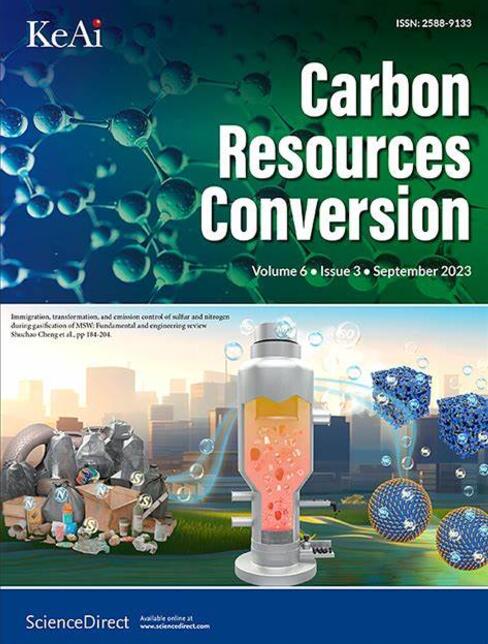Chemically activated carbons derived from cashew nut shells as potential electrode materials for electrochemical supercapacitors
IF 7.5
3区 环境科学与生态学
Q2 ENERGY & FUELS
引用次数: 0
Abstract
Supercapacitors are widely recognized as energy storage solutions due to their high power densities and long cycle lives. Furthermore, there is growing scientific and technological interest in converting biomass waste into carbon materials for manufacturing supercapacitor electrodes. In addition to their abundance and cost-effectiveness, the appeal of carbons derived from biomass lies in their tunable porosity, which enables the rational design of carbon materials to achieve the desired performance of supercapacitors. Here, we present the synthesis of activated carbons from cashew nut shells via potassium hydroxide (KOH) activation at different temperatures (650, 750, and 850 °C). The resulting materials exhibited amorphous and predominant microporous structures. Increasing the activation temperature led to a rise in specific surface area from 1534 to 2034 m2 g−1 and an increased proportion of mesopores. The electrochemical properties of these activated carbons for supercapacitor applications were investigated by cyclic voltammetry, galvanostatic charge–discharge, and impedance spectroscopic techniques in a 1 M sodium sulfate (Na2SO4) electrolyte. Using a three-electrode system, the activated carbons treated at 750 °C exhibited a maximum specific capacitance of 106 F g−1 at a current density of 0.5 A g−1 with a good rate capability; they retained 75 % at 10 A g−1 over a 1.0 V voltage window. Furthermore, a symmetric supercapacitor coin-cell, fabricated with activated carbons treated at 750 °C as the positive and negative electrodes, demonstrated an energy density of 2.43 Wh kg−1 at a power density of 1002 W kg−1. The cell exhibited 87 % capacitance retention at 1.0 A g−1 after 10,000 cycles. This work showcases the efficient and sustainable utilization of cashew nut shells as a carbon source for supercapacitor applications and highlights their value in a circular economy.

从腰果壳中提取的化学活性炭作为电化学超级电容器的潜在电极材料
超级电容器因其高功率密度和长循环寿命而被广泛认为是储能解决方案。此外,将生物质废物转化为制造超级电容器电极的碳材料的科学和技术兴趣日益浓厚。除了丰度和成本效益外,生物质碳的吸引力还在于其可调节的孔隙度,这使得碳材料的合理设计能够实现超级电容器的预期性能。本文以腰果壳为原料,在650、750和850℃的不同温度下,通过氢氧化钾(KOH)活化合成了活性炭。所得材料表现出非晶和微孔结构。随着活化温度的升高,材料的比表面积从1534 m2 g−1增加到2034 m2 g−1,介孔比例增加。采用循环伏安法、恒流充放电法和阻抗光谱技术,在1 M硫酸钠(Na2SO4)电解液中研究了这些超级电容器用活性炭的电化学性能。采用三电极体系,750℃处理后的活性炭在0.5 a g−1电流密度下的最大比电容为106 F g−1,具有良好的倍率性能;在1.0 V电压窗口下,在10a g−1下,它们保留了75%。此外,以750℃活性炭为正极和负极制备的对称超级电容器硬币电池,在1002 W kg - 1的功率密度下,其能量密度为2.43 Wh kg - 1。在1.0 A g−1下循环10000次后,电池的电容保持率为87%。这项工作展示了腰果壳作为超级电容器应用的碳源的高效和可持续利用,并突出了它们在循环经济中的价值。
本文章由计算机程序翻译,如有差异,请以英文原文为准。
求助全文
约1分钟内获得全文
求助全文
来源期刊

Carbon Resources Conversion
Materials Science-Materials Science (miscellaneous)
CiteScore
9.90
自引率
11.70%
发文量
36
审稿时长
10 weeks
期刊介绍:
Carbon Resources Conversion (CRC) publishes fundamental studies and industrial developments regarding relevant technologies aiming for the clean, efficient, value-added, and low-carbon utilization of carbon-containing resources as fuel for energy and as feedstock for materials or chemicals from, for example, fossil fuels, biomass, syngas, CO2, hydrocarbons, and organic wastes via physical, thermal, chemical, biological, and other technical methods. CRC also publishes scientific and engineering studies on resource characterization and pretreatment, carbon material innovation and production, clean technologies related to carbon resource conversion and utilization, and various process-supporting technologies, including on-line or off-line measurement and monitoring, modeling, simulations focused on safe and efficient process operation and control, and process and equipment optimization.
 求助内容:
求助内容: 应助结果提醒方式:
应助结果提醒方式:


